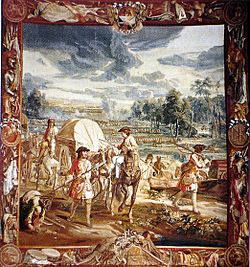Battle of Wijnendale facts for kids
Quick facts for kids Battle of Wijnendale |
|||||||
|---|---|---|---|---|---|---|---|
| Part of the War of the Spanish Succession | |||||||
 Tapestry representing the battle of Wijnendale (1708) in Blenheim Palace, residence of the Duke of Marlborough, showing in the foreground the allied convoy, on the right Wijnendale Castle. |
|||||||
|
|||||||
| Belligerents | |||||||
| Commanders and leaders | |||||||
| Strength | |||||||
| 7,500 men | 22,000 | ||||||
| Casualties and losses | |||||||
| 1,000 | 2,000 | ||||||
The Battle of Wijnendale was an important fight during the War of the Spanish Succession. It happened on September 28, 1708, near a place called Wijnendale in what is now Belgium. This battle was between an army protecting vital supplies and French and Spanish forces. The good guys (the Allies) won, which helped them capture the city of Lille.
Contents
Why the Battle of Wijnendale Happened
After a big win at the Battle of Oudenaarde in July 1708, two famous generals, Marlborough and Prince Eugene of Savoy, decided to attack the city of Lille. Lille was a very strong city with modern defenses designed by a famous engineer named Vauban. It also had a large army of 16,000 soldiers defending it.
The Problem of Supplies for Lille
The attack on Lille wasn't going as planned. The Allied army was running low on ammunition and other supplies. To make things worse, the French army had cut off their usual supply routes from the east. This meant the only way to get supplies was by ship from England to the port of Ostend, which was about 75 kilometers (47 miles) away from Lille.
Marlborough ordered the needed supplies to be sent to Ostend. From there, a huge convoy of 700 slow wagons was organized to carry the goods overland to Lille. This important convoy was protected by 6,000 foot soldiers and 1,500 cavalry (soldiers on horseback). They were led by Major General John Richmond Webb and Brigadier Cornelis van Nassau-Woudenberg.
French Plan to Stop the Convoy
The commander of the French army in Bruges, Count de la Mothe, found out about this valuable convoy. He quickly gathered a large force of 22,000 to 24,000 soldiers. His plan was to intercept the convoy near Wijnendale and stop the Allies from getting their much-needed ammunition.
How the Battle of Wijnendale Was Fought
General Webb knew the French army was coming, and a fight was unavoidable. He needed a clever plan because his army was much smaller than the French force. He used the natural landscape around Wijnendale to his advantage. He chose an open area that was surrounded by woods and hedges on both sides.
Webb's Smart Battle Plan
Webb placed his soldiers in two long lines across this open space, blocking the way. Later, a third line was formed when more soldiers arrived from Oudenburg. While Webb was setting up his defenses, the convoy of wagons kept moving slowly towards Lille, hoping to get past the battle.
Meanwhile, a Prussian general named Carl von Lottum, with only 150 cavalry, bravely bothered the approaching French army. This gave Webb valuable time to get his troops ready. It also stopped the French commander, de la Mothe, from properly scouting the area and understanding Webb's plan.
The French Attack Begins
When de la Mothe's large army arrived at the open space, he expected an easy victory. He set up his army for attack. Between 4 and 5 in the afternoon, the French cannons started firing. When de la Mothe saw that his artillery wasn't doing much damage, he ordered his foot soldiers to charge forward.
The huge French force struggled in the narrow terrain and suffered many losses from the Allied first line, which held its ground firmly. Then, Webb gave the order for the Prussian, Hanoverian, and Dutch soldiers, who were hidden in the woods on both sides, to open fire. This surprise attack from the flanks caused even more damage to the French.
The Allies Hold Their Ground
Even though they were losing many soldiers, de la Mothe ordered a second attack. This attack pushed the Allied first line back a little at first. But with help from the second line and the constant firing from the hidden soldiers on the sides, the French attack was stopped. They were forced to retreat and leave the battlefield.
Just as the battle was almost won, Allied cavalry led by William Cadogan arrived. Marlborough had sent him from Lille because he was worried about the ammunition convoy.
What Happened After the Battle
The Battle of Wijnendale lasted about two hours and was very costly. Around 2,000 French soldiers were killed or wounded. The Allies lost about 1,000 soldiers, mostly from the early cannon fire.
The most important result was that the convoy of supplies reached Lille safely on September 29. This allowed the attack on Lille to continue. Three weeks later, on October 22, the city was finally captured by the Allies.
General Webb and Nassau-Woudenberg received much praise for their bravery and clever tactics. In the French army, many blamed the Spanish soldiers for the defeat, but their own commander, de la Mothe, was also strongly criticized.
Images for kids



